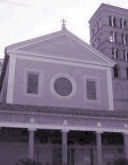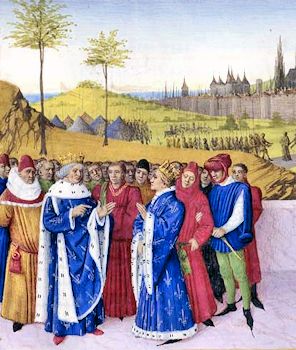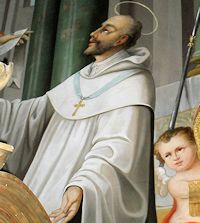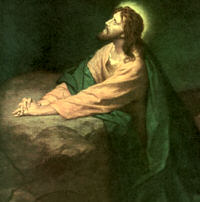Lent: March 28th
Friday of the Third Week of Lent
Other Commemorations: St. Gontran, King (RM; St. Stephen Harding, Abbot (RM) ; Other Titles: St. Contran or St. Guntramnus or Guntram
» Enjoy our Liturgical Seasons series of e-books!
Good Friday is three weeks away. The conflict between Jesus and the religious leaders of his time continues to intensify as the Third Week of Lent draws to an end. In today’s gospel reading, one of the Temple scribes gives Jesus an orthodoxy check, asking him to name the greatest of the Commandments. The answer given (love of God and love of neighbor) suffices to end that line of theological attack on the unexpected Galilean preacher and miracle-worker: “And after that, no one dared to ask him any questions.” But the conflict will grow sharper in the weeks ahead. —George Weigel, Roman Pilgrimage: The Station Churches
The Roman Martyrology today honors St. Gontran (d. 592), also known as Contran or Guntramnus. He was the son of King Clotaire and the grandson of Clovis I. He was raised pagan and became King of Orleans in 561.
St. Stephen Harding (1060-1134) is also commemorated today. He became a monk at Molesme Abbey and with St. Robert of Molesme began the Cistercian reform by helping found Citeaux Abbey in 1098. He joyfully accepted St. Bernard and his companions when they joined the Cistercians.
Meditation for Friday of the Third Week of Lent—Precious to God
If we attend to the passion of Christ we hear a voice insisting 'Someone died for you.' And of that someone dying it can with all truth be said that God is there, bearing the burden of our wrongdoing, the burden of our pain, loneliness and death. God is there loving us totally, holding back nothing. And because He died for us and lived for us, our lives in all their trivialities, their joys and burdens, have meaning in Him. They hold Him within them, through them we can surrender to Him.
How precious we must be to God! How momentous our life span! Yet we value ourselves so lightly, waste the precious content of our being, never reach fulfillment. We do not really live but allow life to pass us by.
God wants us to seize hold of life, hoard its unique opportunities for growth, grasps its chances to express our love and gratitude to Him who loved us first.
Every moment of our life can be filled with eternity, because at every moment, in every event and circumstance we can say or 'Yes' to God who wills us to live to capacity, wills us to act as full persons.
How many of us act from our inmost centre according to principles, not merely following the crowd, the line of least resistance, seeking immediate satisfactions and appreciation? Meanwhile the days and years pass by and we remain essentially undeveloped.
Yet Someone died for us that we might live with abundant life.
—Ruth Burrows, Through Him, With Him, In Him

Friday of the Third Week of Lent
Station with San Lorenzo in Lucina (St. Lawrence in Lucina):
The original church dedicated to the popular deacon martyr St. Lawrence was erected in the 4th century on the ruins of a house belonging to the Roman lady Lucina. Near the church was a well which was very dear to the Romans and which probably suggested the Epistle and Gospel of today's Mass. The church also contains a part of the gridiron on which St. Laurence was burned. The Introit and Gradual from the previous Missal (1962) refer to the prayers of the Saint while he was being tortured.
For more on San Lorenzo in Lucina, see:
- Churches of Rome
- The Station Churches in Rome
- Rome Art Lover
- Roman Churches
- PNAC
- Aleteia
- Station Church
- The Catholic Traveler
For further information on the Station Churches, see The Stational Church.
St. Gontran or Guntramnus
 St. Gontran was the son of King Clotaire and grandson of Clovis I and Saint Clotildis. When Clotaire died in 561, his domains were divided among his four sons. While Gontran's brother Caribert reigned at Paris, Sigebert in Metz, and Chilperic in Soissons, he was crowned king of Orleans and Burgundy in 561. He then made Chalons-sur-Saone his capital.
St. Gontran was the son of King Clotaire and grandson of Clovis I and Saint Clotildis. When Clotaire died in 561, his domains were divided among his four sons. While Gontran's brother Caribert reigned at Paris, Sigebert in Metz, and Chilperic in Soissons, he was crowned king of Orleans and Burgundy in 561. He then made Chalons-sur-Saone his capital.
When compelled to take up arms against his ambitious brothers and the Lombards, he made no other use of his victories, gained under the conduct of a brave general called Mommol, than to give peace to his dominions. The crimes in which the barbarous habits of his nation involved him, he effaced by tears of repentance. The prosperity of his reign, both in peace and war, condemns those who suppose that human policy cannot be determined by the maxims of the Gospel, whereas the truth is just the contrary: no others can render a government so efficacious and prosperous.
Saint Gontran always treated the pastors of the Church with respect and veneration. He was the protector of the oppressed, and the tender parent of his subjects. He gave the greatest attention to the care of the sick. He fasted, prayed, wept, and offered himself to God night and day as a victim ready to be sacrificed on the altar of His justice, to avert His indignation, which Saint Gontran believed he himself provoked and drew down upon his innocent people. He was a severe punisher of crimes in his officers and others, and by many wholesome regulations he restrained the barbarous licentiousness of his troops, but no man was ever more ready to forgive offenses against his own person. With royal magnificence, he built and endowed many churches and monasteries.
This good king died on the 23rd of March in 593, in the sixty-eighth year of his age, having reigned thirty-one years.
—Excerpted from Little Pictorial Lives of the Saints, a compilation based on Butler's Lives of the Saints and other sources by John Gilmary Shea (Benziger Brothers: New York, 1894).
Patronage: Divorced people; guardians; repentent murderers
Symbols and Representation: king finding treasure and giving it to the poor; king with three treasure chests, one of which has a globe and cross
Highlights and Things to Do:
- Read more about St. Gontran:
- He was buried in the Church of Saint Marcellus, which he had founded in Chalon. Almost immediately, his subjects proclaimed Gontrand a saint and the Catholic Church celebrates his feast day on 28 March. The Huguenots scattered his ashes in the 16th century. Only his skull remains in the Church of St. Marcellus in a silver case.
- See the print from 1636 in the Met Museum of St. Gontran.
St. Stephen Harding
 Stephen Harding, son of an English noble, was born at Sherborne in Dorsetshire, England, about the middle of the eleventh century. He consecrated himself to the monastic life in the Abbey of Sherbonne in Dorsetshire, where he received his early education. He later studied in Paris and Rome, where he pursued a brilliant course in humanities, philosophy and theology.
Stephen Harding, son of an English noble, was born at Sherborne in Dorsetshire, England, about the middle of the eleventh century. He consecrated himself to the monastic life in the Abbey of Sherbonne in Dorsetshire, where he received his early education. He later studied in Paris and Rome, where he pursued a brilliant course in humanities, philosophy and theology.
After studying in Paris and Rome, he visited the monastery of Molesmes. Impressed by its leaders, Robert of Molesmes and Alberic (who were later canonized), Stephen joined the community.
After a few years, the three men, along with another 20 monks, established a more austere monastery in Citeaux. Eventually, Robert was recalled to Molesme (1099), Alberic died (1110), and Stephen was elected abbot.
Stephen Harding is credited with writing the famous Carta Caritatis (Charter of Charity—often referred to as the Charter of Love). It was a six page constitution which laid out the relationship between the Cistercian houses and their abbots, set out the obligations and duties inherent in these, and ensured the accountability of all the abbots and houses to the underlying themes of charity and living according to the rule of Benedict.
Since the monastery received very few novices, he began to have doubts that the new institution was pleasing to God. He prayed for enlightenment and received a response that encouraged him and his small community. From Bourgogne a noble youth arrived with 30 companions, asking to be admitted to the abbey. This noble was the future St. Bernard. In 1115 St. Stephen built the abbey of Clairvaux, and installed St. Bernard as its Abbot. From it 800 abbeys were born.
In 1133, Stephen resigned as the head of the order, due to age and disability, and died the following year.
—Excerpted from Catholic Fire
Highlights and Things to Do:
- Read more about St. Stephen Harding at EWTN.
- Read Carta Caritatis.
- Learn more about the Cistercians.






